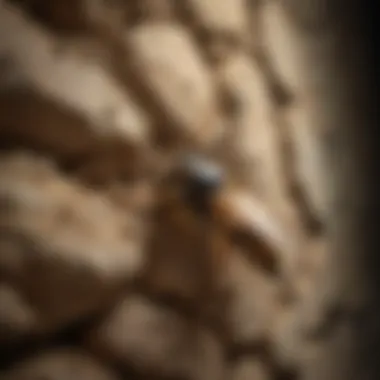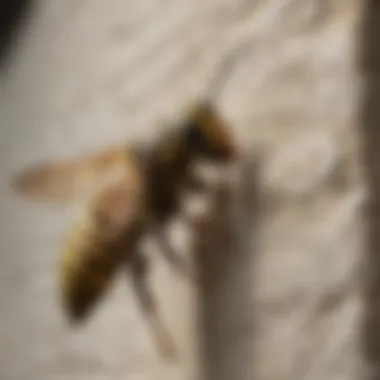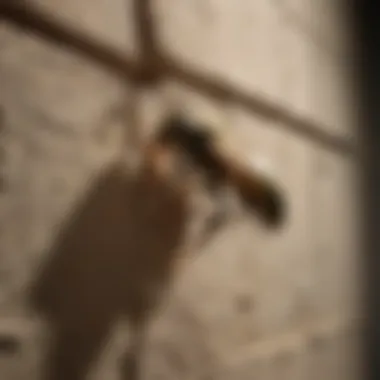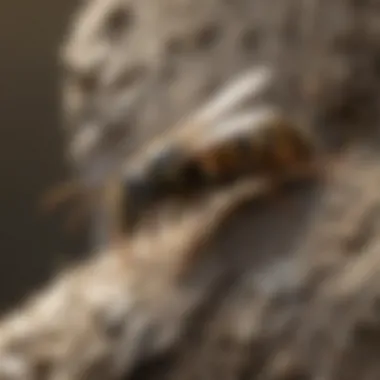Effective Strategies for Dealing with Wasp Infestations in Walls


Intro
Wasps can be an unwelcoming presence in your home when they decide to make their nests within your walls. This can not only lead to discomfort but also poses health risks to you and your family. Understanding the nature of these pests and the actions you can take regarding removal is essential. In this article, we will explore the best strategies for dealing with wasps in your walls, including identification, prevention methods, and control measures.
Understanding the Pest
Wasps are often mistaken for bees, yet they exhibit different behaviors and traits. The first step in managing a wasp problem is proper identification.
Identification
There are several types of wasps that may invade your walls, but the most common are yellow jackets, paper wasps, and hornets. Yellow jackets are characterized by their black and yellow stripes and are notorious for aggressive behaviors, especially when provoked. In contrast, paper wasps have long legs and slender bodies, and they tend to build umbrella-shaped nests. Hornets are larger than the other two and are known for their painful stings. Observing their behavior can help you identify the species residing in your walls.
Life Cycle
Understanding the life cycle of wasps is crucial for effective management. Wasps undergo a complete metamorphosis that includes four stages: egg, larva, pupa, and adult. In spring, fertilized queens emerge from hibernation and begin to build nests, laying eggs that develop into the next generation. As summer progresses, the number of wasps increases, peaking in late summer. By autumn, nests may become abandoned as the temperatures drop, leading to a decrease in wasp activity. Recognizing this cycle can inform your approach and timing when addressing an infestation.
Pest Prevention Strategies
Preventing wasps from entering your walls is possible with some strategic approaches.
Environment Modification
Modify your environment to make your home less attractive to wasps. Remove food sources, such as open garbage cans or fallen fruit. Seal cracks and gaps around window frames, doors, and walls that may serve as entry points. A well-maintained outdoor area can significantly hinder their nesting process.
Physical Barriers
Installing screens on windows and vents is an effective method to block wasps from entering your home. Additionally, covering vents with mesh can prevent them from nesting in areas they find appealing. These physical barriers are a proactive step toward minimizing potential infestations.
Control Methods
If wasps are already nesting in your walls, consider various control methods to manage the situation.
Chemical Control
Chemical insecticides can alleviate active wasp infestations. It is vital to choose products specifically designed for wasps, such as those containing pyrethroids or other targeted ingredients. Safety precautions are crucial; always wear protective clothing and follow the manufacturer’s instructions carefully. Treating the nest at night when wasps are less active is also advisable, as this can reduce your risk of stings.
Biological Control
Another avenue for wasp control is biological options. Introducing natural predators, such as certain birds or insects, may help maintain wasp populations at manageable levels. Research indicates that these natural methods can be effective when combined with environmental modifications.
"Proactive measures and informed responses are essential when managing wasp infestations in your home."
Preamble to Wasp Presence in Homes
Understanding the presence of wasps in homes is crucial for homeowners. Wasps can pose risks not only through their stings but also by causing structural damage when they nest inside walls. Recognizing these issues allows for prompt action, reducing potential harm. This section will explain essential aspects of wasps and their behavior, thus equipping homeowners with knowledge necessary to manage any infestation that may occur.
Understanding Wasp Behavior
Wasps exhibit diverse behaviors that vary according to species, but some general patterns can be witnessed. Typically, they are social insects living in colonies. Their nests are often constructed from paper-like material made from chewed wood fibers and saliva. These nests can be found in multiple locations, including trees, under eaves, or, concerningly, within wall cavities of homes.
Their life cycle consists of four stages: egg, larva, pupa, and adult. Worker wasps perform tasks like foraging for food, maintaining the nest, and caring for young. Unlike bees, wasps can sting multiple times, making them more aggressive when threatened. Being aware of these behaviors is essential for assessing the situation if a nest is discovered in or around your home.
Why Wasps Choose Wall Cavities


Wasps are often drawn to wall cavities due to several environmental factors.
- Protection from Elements: Walls offer shelter from wind, rain, and extreme temperatures.
- Availability of Materials: Homes provide scraps of wood and other fibers, which can be repurposed for nest construction.
- Proximity to Food: Wasps are attracted to areas with food sources, such as leftover pet food or open garbage cans near exterior walls.
When nests are built within walls, the situation can become complicated. The hidden nature of these nests makes detection difficult until the wasps become visibly active, often alarming homeowners. Thus, early identification and preventive measures are highly recommended.
Identifying a Wasp Infestation
Identifying a wasp infestation is a crucial step in managing potential threats posed by these insects. Early recognition allows homeowners to take swift action, minimizing risks to health and safety. Wasps can be aggressive when threatened, and their presence within walls can pose dangers, especially if someone has allergic reactions. Understanding how to identify a wasp infestation not only protects residents but can also save time and money by preventing extensive damage or complications later on. Failure to act quickly can lead to more significant issues, including structural damage within a home.
Signs of Wasp Activity
To recognize if wasps are residing in your walls, there are specific indicators that can be observed. These signs might vary, but they all play a role in confirming an infestation.
Vocalizations and Sounds
Vocalizations and sounds are often the first signs of wasp presence. Homeowners may hear a buzzing or humming sound emanating from the walls. This noise is particularly pronounced during warmer months when wasp activity peaks, as they spend more time busy with their nests. This sound can be quite distinctive, making identification more manageable.
The key characteristic of these sounds is their persistent nature. They are often louder at certain times of day, particularly during the late afternoon when wasps are more active. This is especially helpful for confirming the presence of a nest. One unique feature regarding wasp sounds is that they can sometimes indicate the location of the nest if one is nearby. However, it is important to note that not every buzzing sound may relate to wasps; other insects might produce similar noises as well. Hence, care must be taken to observe additional signs of activity.
Nesting Material
Nesting material is another solid indicator of wasps in your walls. Wasps gather various items like paper, wood fibers, and plant matter to construct their nests. Homeowners might notice trimmings or fragments near potential entry points or around the exterior of the house.
The critical characteristic of nesting material is its appearance. Wasps often create nests that resemble paper mâché structures. These can be found in wall cavities or eaves. Discovering these materials highlights their nesting activity and serves as a clear indicator that further investigation is needed. One advantage of identifying nesting material is that it can help pinpoint the location of the nest. However, it’s also crucial to ensure safety while doing this, as wasps may become aggressive if their nest is disturbed.
Visual Sightings of Wasps
Visual sightings of wasps represent a direct and obvious sign of an infestation. Observing wasps flying into and out of a particular area, such as holes or gaps in walls, is a clear indication of their presence. Homeowners are generally encouraged to watch these patterns for a better understanding of wasps' activities.
The key characteristic of visual sightings is their unmistakability. Wasps are often larger and more elongated than bees, making them easier to distinguish when observed. This is beneficial as it helps homeowners validate suspicions regarding an infestation. Specific features like coloration—yellow and black stripes—can aid in identifying which insect is present. Nonetheless, a drawback of only relying on visual sightings is that they may not always be consistent; some wasps could be hidden within walls while others may remain out of sight.
Differentiating Wasps from Bees
Lastly, it’s essential to differentiate between wasps and bees. While both belong to the same order, Hymenoptera, their behavior and roles are distinct. Wasps typically have a more streamlined body and often have minimal body hair compared to bees. Understanding these differences is vital for appropriate intervention. Misidentification can lead to improper pest management methods, posing more risk than relief. Wasps are more aggressive than bees and have different nesting habits, making it imperative to know exactly what is at stake before attempting any removal or management strategies.
Assessing the Situation
Assessing the situation when wasps are found in the walls is crucial. This process involves understanding the location of the nest, evaluating risks associated with removal, and planning a course of action. Without proper assessment, attempts to deal with the issue could lead to unnecessary injuries and complications. By carefully evaluating various aspects, homeowners can make informed decisions that enhance safety and effectiveness in resolving the infestation.
Locating the Nest
Locating the nest is the first step in dealing with a wasp infestation. Wasps typically build nests in hidden areas, such as wall cavities, attics, or beneath eaves. Common signs indicating the nest's proximity include increased wasp activity near certain areas of the house. Observing their flight patterns can guide homeowners to the nest’s entrance. This is vital to know because if the nest is disturbed, the wasps may react aggressively.
Evaluating the Risk of Removal
When faced with wasps in the walls, evaluating the risk of removal becomes imperative. There are several factors to consider in this evaluation, including the number of wasps, the distance from living areas, and any existing allergies.
Number of Wasps
The number of wasps involved in the infestation is a significant factor. A small number may be manageable, making DIY removal a viable option. Conversely, a large population presents a heightened risk of stings. Furthermore, the size of the nest often correlates with the level of aggression. A larger nest typically indicates a more established presence, which may lead to more defensive behavior when disturbed. Thus, understanding the number of wasps helps in determining whether to proceed with DIY methods or seek professional help.
Distance from Living Areas


The distance from living areas greatly impacts the decision-making process. If the nest is situated away from frequently occupied spaces, the immediate risk is lower. However, if the nest is close to living areas, children, or pets, caution is essential. Wasps may feel threatened and aggressive if their nest is nearby. This is why assessing the distance from living areas is important. It helps gauge the urgency of the removal.
Allergies and Health Risks
Consideration of allergies and health risks cannot be overlooked. Some individuals may have severe allergic reactions to wasp stings. Therefore, if there is a known allergy among household members, this knowledge directs the approach to removal. This factor heightens the need for utmost caution. Understanding allergies and health risks serves as a guide in deciding whether to handle the situation independently or engage professional pest control services to ensure safety.
Safe Removal Techniques
Safe removal techniques are crucial when dealing with wasps that have made their home in your walls. Understandably, there is a desire to mitigate the problem efficiently while also ensuring personal safety. The methods employed can greatly influence the outcome of the removal process. Factors such as the extent of the infestation, type of wasp, and proximity to living spaces should all be taken into account.
Employing safe techniques reduces the risk of stings and can prevent the wasps from becoming more aggressive. Furthermore, using non-toxic methods helps maintain a safe environment for both humans and pets in the household. This article will delve into various strategies that ensure effective wasp removal while prioritizing safety.
DIY Removal Methods
When it comes to wasp removal, many homeowners consider DIY methods first. These techniques can be both economical and accessible. However, careful planning is important to avoid danger.
Traps and Baits
Traps and baits provide a straightforward approach for managing wasps. They attract wasps using enticing scents and potentially lethal substances. One key characteristic is their ability to reduce the wasp population without direct confrontation. This makes traps a beneficial choice for homeowners. The unique feature of these traps is that they can be placed away from high-traffic areas, which minimizes the risk of being stung.
However, despite the benefits, there are disadvantages. Traps may not eliminate the entire nest immediately, and patience is required. Additionally, the effectiveness can vary based on the season and the wasp species.
Nesting Material Removal
Nesting material removal is another effective DIY method. This technique involves reducing or removing access to the materials that foster wasp nest construction. It is popular because it addresses the root cause of the infestation. By removing materials, such as wood and paper, it becomes less appealing for wasps to build nests near your home.
A unique feature of this method is that it can serve as a preventive measure. However, one must be cautious while attempting this. Improper removal can provoke the wasps, leading them to defend their territory aggressively.
Timing for Effective Removal
Timing is an essential factor in effective wasp removal. Knowing when to act can greatly influence the success of your efforts. It is often recommended to conduct removal during the evening or at night when wasps are less active. This timing is advantageous because wasps are more likely to be inside the nest, and their agitation levels are lower.
A unique benefit of adhering to timing is the decreased chance of disturbance leading to stings. However, one should be prepared for some unpredictability. If the nest gets disturbed, a swift reaction is required to minimize potential risks.
When to Call Professionals
While DIY methods can be effective, there are situations where calling professionals is the safest choice. If the nest is large or hard to reach, or if family members have allergies to wasp stings, it’s prudent to seek expert assistance. Professional pest control services have the expertise, equipment, and safety measures necessary to deal with complex infestations effectively.
In summary, while the DIY approach offers flexibility and cost savings, it is essential to evaluate the situation carefully. Determine if your capability level matches the needs of the infestation to ensure a safe resolution.
Preventing Future Infestations
Preventing wasps from returning is as crucial as managing an existing infestation. A proactive approach can save homeowners from the stress and risks associated with wasp presence. By focusing on specific elements like sealing entry points, conducting regular inspections, and making informed landscaping choices, you can significantly reduce the chances of wasps nesting in your walls.
Sealing Entry Points
Sealing entry points is one of the first lines of defense against wasps. Wasps can enter homes through remarkably small openings. Common entry spots include gaps in doors, windows, and the foundation. To effectively seal these points, using caulk or weather stripping is recommended. Additionally, it is important to check for cracks in walls and around utility lines, as these can also provide access.
If you notice any deteriorating materials, replace these as soon as possible. Ensuring the structural integrity of your home reduces the risk of wasps finding a suitable nesting site. This simple yet effective step serves as a barrier that keeps wasps outside where they belong.
Regular Inspections
Monitoring your home periodically for signs of wasps is a practical strategy. Regular inspections help identify potential problem areas before they turn into infestations. Focus on inspecting wall cavities, eaves, and attics. Look for nesting materials, wasp activity, or even the presence of wasps themselves.


During inspection, pay attention to any unusual sounds. Wasps often make distinctive noise, particularly when building nests. An early intervention can lead to easy solutions. Creating a schedule for these inspections, especially during warmer months when wasp activity peaks, is wise.
Landscaping Considerations
Landscaping plays a significant role in reducing wasp attraction to your home. Making informed choices about plants and yard maintenance can minimize potential nesting sites. Wasps are drawn to areas rich in food and shelter, so careful management of your outdoor space is essential.
Plant Selection
Selecting the right plants can decrease the likelihood of attracting wasps. Certain varieties are known to be less appealing to these insects. For instance, plants with less nectar, such as lavender and rosemary, tend to attract fewer wasps compared to more nectar-rich options.
Additionally, focusing on maintaining a balance in your garden, with plants that keep pests in check, is beneficial. Thus, selecting appropriate flora can influence the overall pest dynamics around your home, making it a more hostile environment for wasps.
Yard Maintenance
Yard maintenance is vital in preventing future wasp infestations. Keeping your yard clean reduces places where wasps can nest or find food. Regularly removing fallen fruit, clearing debris, and managing waste effectively can deter wasps from settling nearby.
Moreover, trimming overgrown areas ensures wasps do not have desirable shelter spaces. An orderly yard not only enhances aesthetics but also serves as a tactical advantage against pests. Consider making yard maintenance part of your seasonal routine to stay ahead of potential infestations.
Preventing wasp infestations requires diligence, but with the right strategies, it is achievable.
Understanding the Environmental Role of Wasps
Wasps often provoke a sense of fear in many people due to their potential for stings and the sudden appearance during outdoor activities. However, understanding the environmental role of wasps can shift this perspective. They are not merely pests; they contribute significantly to the ecosystem. Recognizing their benefits aids in striking a balance between necessary pest management and ecological health.
Beneficial Aspects of Wasps
Wasps are crucial players in maintaining ecological balance. They are predators of various insects, including caterpillars, aphids, and other garden pests. This predatory behavior helps control these populations naturally, reducing the need for chemical pesticides in gardens and farms. Additionally, some wasp species facilitate pollination, contributing to the growth of plants and crops.
- Biological Control: Wasps serve as natural pest control agents. Their hunting habits can limit the number of harmful insects, thus helping protect crops and gardens.
- Pollination: While bees are more known for pollination, wasps also visit flowers for nectar. They contribute to the pollination of many plants, promoting biodiversity.
In this respect, wasps can be viewed as beneficial insects, essential for a healthy ecosystem.
Balancing Human and Pest Interactions
The interaction between humans and wasps can often result in conflicts. Understanding this balance is necessary for coexistence. The key lies in responsible management and education regarding wasp behavior.
- Awareness of Seasonality: Many wasp species are more aggressive in late summer and early fall when food becomes scarce. Being aware of these timings can help homeowners take precautions.
- Preventive Measures: Simple steps such as sealing entry points and removing food sources around homes can mitigate risks. This proactive approach minimizes conflict while respecting the role of wasps in the environment.
Addressing the issues around wasps requires an informed and measured approach. Educating oneself about their role in keeping ecosystems balanced can reduce the fear surrounding them and promote a harmonious relationship between humans and nature.
"Understanding the value wasps bring to our environment can transform the narrative of fear into one of appreciation and coexistence."
Wasps play a multifaceted role in the environment, and recognizing this is essential for effective pest management strategies.
Finale
In addressing wasp infestations in wall cavities, the conclusion serves as an essential element of this article. It encapsulates the key insights and actionable steps homeowners can take to manage these pests effectively. By summarizing the information provided throughout this guide, the conclusion reinforces the importance of awareness and preparedness in encountering such situations. Moreover, it highlights the specific benefits of understanding wasp behavior, identifying signs of infestation, and implementing safe removal methods.
Summarizing Key Takeaways
The understanding of wasps and their habitation choices is crucial. Here are the primary takeaways from the article:
- Identification is the first step. Recognizing signs of wasp activity is essential for timely action.
- Safety Considerations should not be overlooked. Assessing the risks associated with wasp removal is vital for the well-being of both homeowners and professionals.
- Prevention Strategies play a key role. Sealing entry points and conducting regular inspections can significantly reduce the likelihood of future infestations.
- Environmental Awareness is important. Acknowledging the beneficial aspects of wasps while managing their presence helps maintain ecological balance.
Encouraging Responsible Pest Management
Responsible pest management incorporates a balanced approach that emphasizes the safety of both humans and the environment. Homeowners are encouraged to:
- Educate Themselves about wasp behavior and nests. This knowledge will aid in making informed decisions about managing infestations.
- Utilize Safe Removal Techniques, prioritizing non-lethal methods whenever possible, allowing for coexistence when feasible.
- Consider Professional Help when the situation escalates beyond personal capabilities, especially for those with allergies or severe infestations.
By incorporating these considerations into daily practices, homeowners can enhance their pest management strategies. This ensures safety, while appreciating the ecological role wasps play in the environment.







